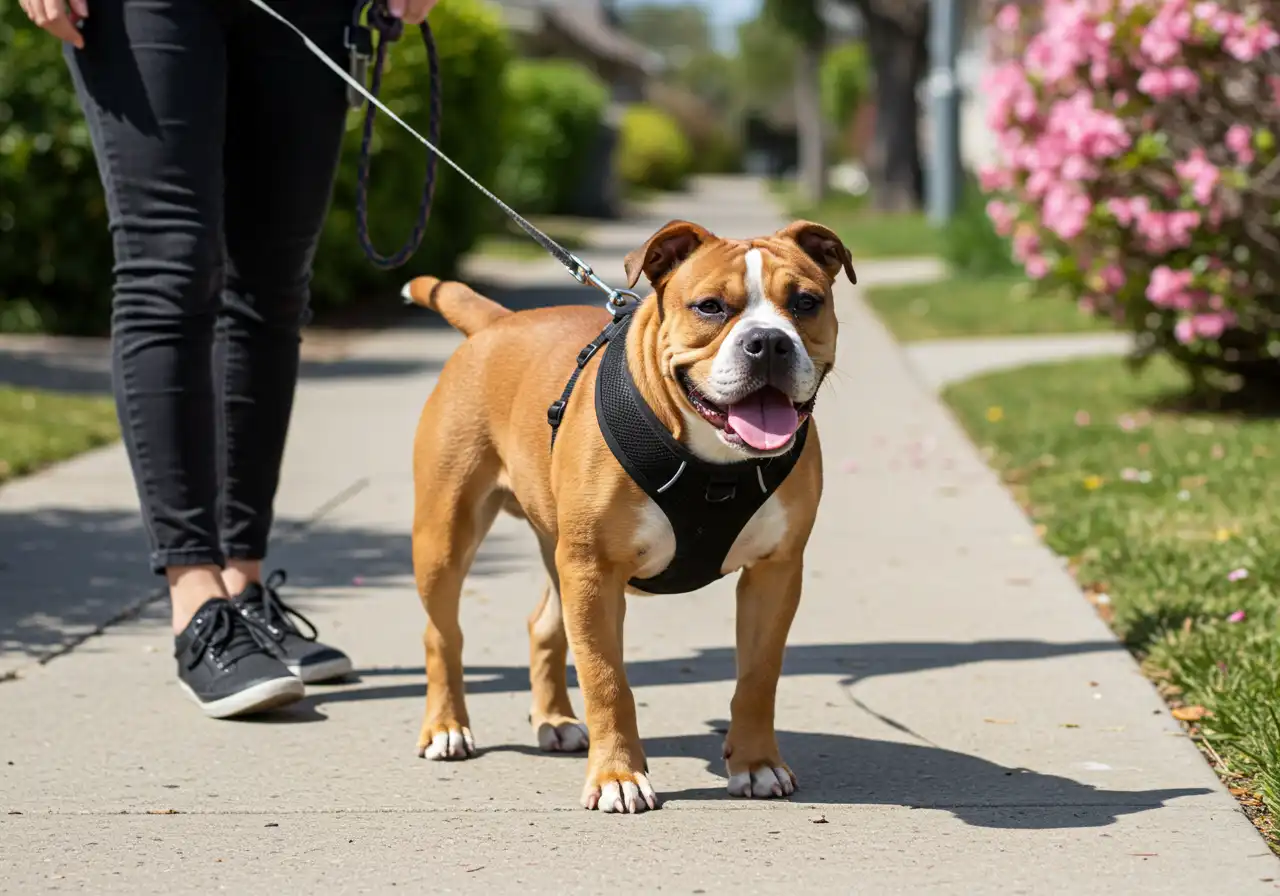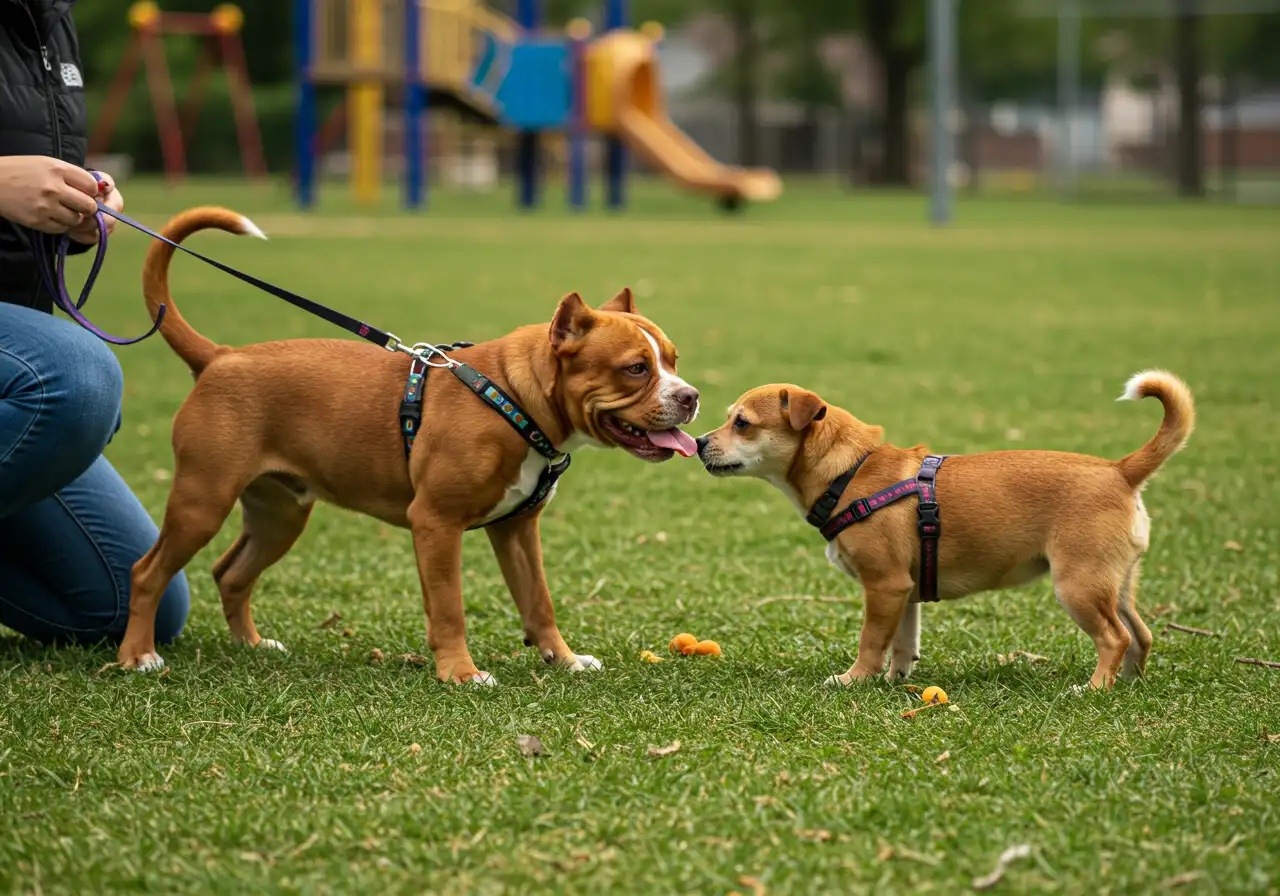The Continental Bulldog, developed in Switzerland in the early 2000s, is a healthier and more athletic alternative to the English Bulldog. This medium-sized breed stands 16–19 inches tall and weighs between 50–66 pounds. Known for its friendly, lively, and affectionate temperament, the Continental Bulldog makes an excellent family companion.
Proper care for a Continental Bulldog puppy is essential to ensure they grow into healthy and well-adjusted adults. Given their muscular yet developing body structure, special attention is needed for physical activity, nutrition, grooming, training, and socialization. This guide will provide you with the essential information on how to care for your Continental Bulldog puppy effectively.
Physical Activity Guidelines for Your Continental Bulldog Puppy
Physical activity guidelines are crucial for the well-being of your Continental Bulldog puppy. Gradually increasing physical activity is important to prevent injuries and ensure healthy development. Puppies have underdeveloped musculoskeletal systems, making them susceptible to injuries like broken knee ligaments and worsened hip dysplasia if overloaded.
Specific Recommendations
1. Leash Walks:
- Start with short walks at around 2 months old.
- Increase the distance monthly, reaching approximately 1.5 km by 12 months.
- By 18 months, regular walks can be up to 3 km.
2. Off-Leash Playtime:
- Limit off-leash playtime to avoid physical strain.
- At 12 months, playtime should be up to 20 minutes.
- By 18 months, increase off-leash playtime to a maximum of 40 minutes.
Risks of Overloading
Overloading your puppy physically can lead to long-term health issues. Ensuring a balanced exercise routine tailored for gradual growth helps prevent stress on developing bones and joints. Monitoring your puppy’s physical condition regularly will help adjust activity levels appropriately.
Nutrition Tips to Support Healthy Growth in Your Continental Bulldog Puppy

Puppy nutrition is crucial for lifelong health, especially in a strong breed like the Continental Bulldog. During periods of rapid growth, it’s important to pay close attention to what you feed your puppy.
1. Tailored Diets for Growth Stages
Choose a high-quality puppy food specifically designed for medium or large breeds. These diets have controlled levels of calcium and phosphorus to promote gradual bone development and reduce the risk of joint problems later on. Look for foods that clearly state their intended life stage and size range.
2. Joint Supplements for Puppies
Since this breed is prone to hip dysplasia and musculoskeletal issues, early support is vital. Many owners include joint supplements for puppies, such as glucosamine, chondroitin, or omega-3 fatty acids (from fish oil) in their dog’s diet to promote healthy cartilage and tendon formation. Always consult your veterinarian before adding any supplements.
3. Monitoring Physical Condition
Pay close attention to your puppy’s body condition score. You should be able to easily feel their ribs without any excess fat covering them. Rapid or excessive weight gain puts additional strain on developing joints, so avoid overfeeding treats or table scraps.
Healthy growth isn’t about getting big quickly; it’s about building strong bones, flexible joints, and balanced development.
Nutritional requirements change rapidly during the first 18 months of your puppy’s life. Instead of solely relying on the guidelines provided on the packaging, adjust portion sizes based on your puppy’s activity level and growth rate.
Grooming Requirements for Your Continental Bulldog Puppy’s Well-being
Puppy grooming is a crucial part of “The Ultimate Guide to Caring for Your Continental Bulldog Puppy.” This breed has moderate grooming requirements that are manageable with a consistent routine.
1. Weekly Brushing
The Continental Bulldog’s short, dense coat benefits from weekly brushing. A soft-bristle or rubber grooming mitt removes loose hair and distributes natural oils for a healthy shine. This reduces shedding and helps spot skin issues early.
2. Occasional Baths
Bathing every 4–6 weeks, or when the puppy is particularly dirty, keeps the coat clean without stripping essential oils. Mild dog shampoos formulated for sensitive skin are recommended due to occasional skin sensitivities in this breed.
3. Teeth Brushing
Dental care is often overlooked but remains vital. Brushing teeth several times per week helps prevent tartar buildup and gum disease. Choose canine toothpaste and start early to build positive associations.
4. Ear Checks
Regular ear inspections prevent wax buildup and detect infections. Use a damp cotton pad to gently wipe the outer ear if needed—avoid deep cleaning that could cause injury.
5. Nail Trimming
Active puppies may wear down nails naturally, but regular trimming prevents pain or mobility issues. Monthly trims using proper dog nail clippers maintain paw health.
Grooming requirements for Continental Bulldogs typically demand around 30–45 minutes weekly, with baths and nail trims scheduled as needed. Creating a calm environment during these routines supports trust-building and reinforces your daily bond with your puppy.
Exercise Needs and Mental Stimulation Strategies for Adult Continental Bulldogs
Exercise needs for adult Bulldogs go beyond a simple walk around the block. A healthy, well-adjusted Continental Bulldog thrives on consistent daily activity. Aim for at least one hour of exercise per day, split between structured leash walks and free-form play.
Leash Walks
These should be brisk but controlled, lasting around 30–40 minutes. Vary your routes to introduce new scents and sights, which helps keep your Bulldog mentally engaged as well as physically fit.
Off-Leash Playtime
Secure environments or fenced yards give your Bulldog the chance to run, chase toys, and interact freely. Sessions of 20–30 minutes encourage agility and burn off excess energy.
Mental stimulation through exercise is just as critical as physical movement. Continental Bulldogs are intelligent and appreciate activities that challenge their minds:
- Puzzle toys filled with treats
- Hide-and-seek games using favorite toys
- Short training sessions that reinforce obedience or teach new tricks during or after walks
A bored Bulldog can develop undesirable behaviors such as chewing or excessive barking. Rotating activities and introducing new challenges maintain interest while supporting emotional balance.
Blending structured walks with active play ensures not only muscle tone but also a strong bond between you and your dog. This balanced approach lays the groundwork for a calm, content companion ready for the next stage of training and socialization.
Effective Training Methods to Shape Your Continental Bulldog Puppy’s Behavior
Positive reinforcement training stands out as the most effective approach with Continental Bulldog puppies. This breed responds best to rewards—treats, praise, or play—when they display desired behaviors. Harsh corrections or punishment-based techniques often lead to stubbornness or anxiety rather than cooperation. You want your puppy eager to participate and not fearful of making mistakes.
Key principles for successful training:
- Start early: Begin basic commands like sit, stay, and come as soon as your puppy settles in at home, ideally around 8–10 weeks old. Early training for puppies capitalizes on their natural curiosity and adaptability.
- Consistency is critical: Use the same cues and reward system for each behavior. Mixed signals slow learning and can confuse a Continental Bulldog, which thrives on routine.
- Short sessions: Keep lessons brief—5 to 10 minutes—to match attention spans and prevent frustration.
- Reward immediately: Deliver treats or praise the moment your puppy completes the correct action so they understand what earned the reward.
“With consistent positive reinforcement, you’ll see your Continental Bulldog puppy develop into a confident, trustworthy companion eager to learn new things.”
Training isn’t just about obedience—it’s about building trust. When you use positive methods from day one, you foster respect and strengthen your bond with your dog.
The Importance of Socialization and Environmental Exposure in Raising a Well-rounded Continental Bulldog Puppy
Why Early Socialization Matters
Early socialization with other dogs and regular exposure to new environments are essential aspects of raising a Continental Bulldog puppy. These experiences help shape a confident, adaptable companion who is comfortable in different situations as an adult. Puppies exposed to a variety of sounds, sights, people, and animals during their critical developmental window are less likely to develop anxiety or fear-based behaviors.
Key Benefits of Socialization and Exposure
- Improved confidence: Meeting friendly dogs and new people builds trust and reduces reactivity.
- Better adaptability: Exploring different locations—parks, busy streets, pet-friendly stores—teaches your puppy to handle unfamiliar places calmly.
- Healthier relationships: Positive play sessions with well-mannered dogs encourage good canine manners and communication skills.
Finding the Right Balance
Balancing these experiences is crucial. The Ultimate Guide to Caring for Your Continental Bulldog Puppy emphasizes that overloading your puppy with too many new encounters in one day can be overwhelming. Short, positive outings—followed by rest—are more effective than long, intense periods of stimulation. Watch for signs of fatigue or stress, such as excessive panting or withdrawal. A well-planned approach ensures your puppy develops into a sociable dog without compromising their physical or emotional well-being.
Understanding the Adaptability of Continental Bulldogs to Different Lifestyles and Living Situations
The Continental Bulldog’s adaptable nature makes it well-suited to various living situations and owner profiles. Whether you’re a family, single individual, or a first-time dog owner, this breed can thrive in your environment if its needs are met.
Compatibility with Families
Continental Bulldogs are known for their friendly and affectionate temperament, making them excellent companions for families. They get along well with children and other pets, provided they are properly socialized from an early age.
Ideal for Singles
For single owners, the Continental Bulldog offers loyal companionship. A Continental Bulldog’s moderate exercise needs mean it can fit into a busy lifestyle as long as regular walks and playtime are incorporated.
First-time Owners
This breed is a good choice for first-time dog owners due to its manageable size and trainable nature. Positive reinforcement training methods work well with Continental Bulldogs, helping new owners establish a strong bond.
Living Environment
Whether you live in an apartment or a house, the Continental Bulldog can adapt as long as its exercise requirements are fulfilled. Regular outdoor activities like walks and play sessions are essential to keep this energetic breed happy and healthy.
Meeting these needs ensures that your Continental Bulldog will be a well-adjusted, loving member of your household regardless of your living situation.
Conclusion
Raising a Continental Bulldog puppy brings unique rewards and responsibilities. This breed’s affectionate temperament, intelligence, and adaptability make it a cherished companion for families, singles, and first-time owners alike. The Ultimate Guide to Caring for Your Continental Bulldog Puppy highlights that attentive care—balancing exercise, nutrition, grooming, training, and socialization—lays the foundation for a healthy, well-adjusted dog.
- Summary of puppy care guide:
- Gradually increase physical activity to protect developing joints.
- Prioritize tailored nutrition and joint support.
- Maintain a consistent grooming and dental routine.
- Use positive reinforcement for training and early socialization.
- Meet daily needs for both exercise and mental stimulation.
A Continental Bulldog thrives when you approach every stage with patience, awareness, and genuine affection. The bond you form through thoughtful care not only shapes their future but also enriches your life in lasting ways.


